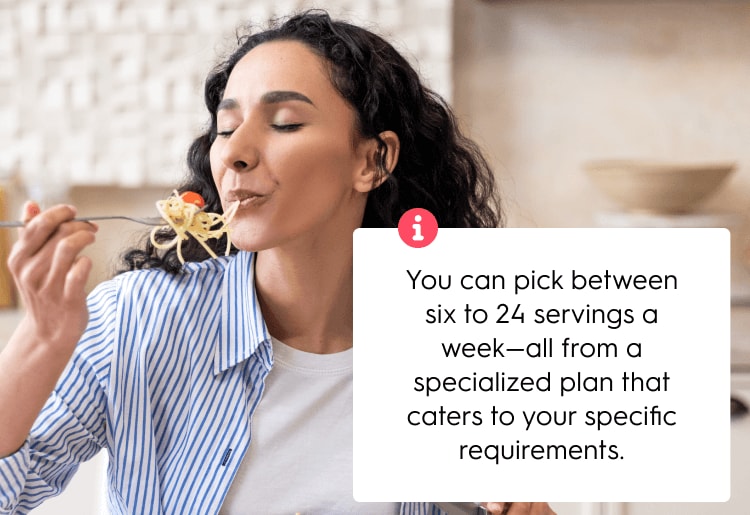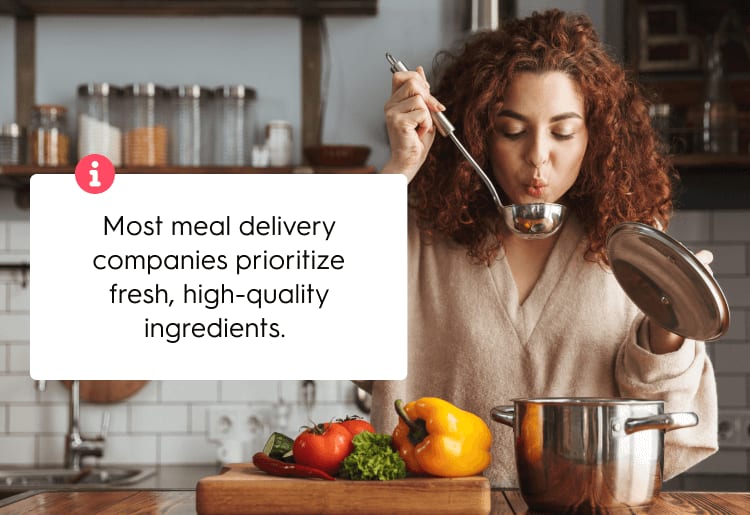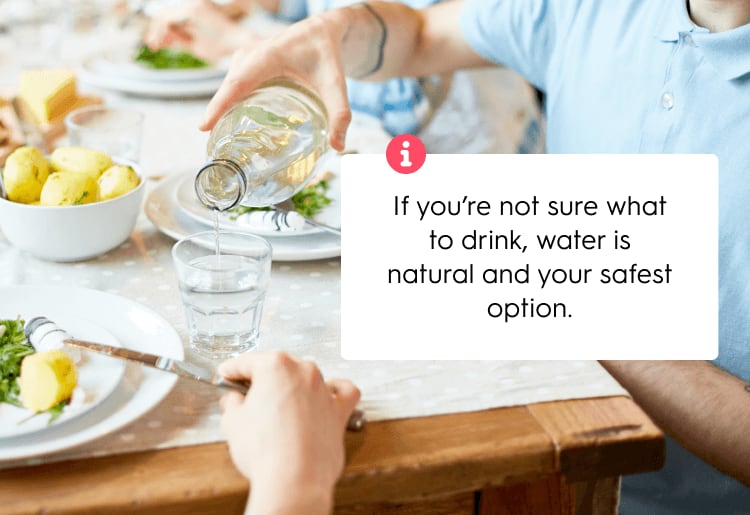From vegetables and dairy to fatigue and weight loss, eating behaviors and dietary requirements differ for everyone. So, how do you stop listening to what works for everybody else and pinpoint the best foods for you?
Listen to your body and consult with a registered dietitian to help you find the answers you’re looking for. With this guidance, you can zero in on foods, recipes, and meal delivery services that fit your diet criteria. As a qualified nutritionist, I’ll help you silence the outside noise and guide you through what to and not to eat.
» Short on meal prep time? Make quick one-skillet meals for your whole family.
1. Balance Your Food Likes With Healthy Alternatives
Maybe you’re reaching for foods you don’t care for much because others say they’re healthy or can help you get fit. But, eating a restrictive diet can increase your cravings and can possibly lead to overeating. Also, it’s difficult to stick to a plan that cuts out all your favorite foods.
A better way to approach healthy eating is to make a list of your likes so you can see where you can improve your current diet. This can give you a better idea of what to look for when ordering from a menu, selecting a meal delivery kit, or searching for recipes.
While enjoying your favorites, you still need to consume various nutrients for good health. So, try to balance what you love with their nutritional value. If some of your preferences aren’t very healthy, look for better alternatives or different ways to prepare them. For example, instead of frying chicken, bake or grill it with spices.
Watch how much you eat as well. Managing portion sizes can help you control your calorie intake. But remember, it’s fine to have unhealthy treats occasionally—just keep it to once or twice a week. This way, you can enjoy what you love without neglecting your well-being.
How Can Meal Delivery Services Help Me Balance My Nutrients?
Meal kits from a service like HelloFresh can make it easier to get the proper nutrients. These kits come with pre-portioned ingredients and easy-to-follow recipes with detailed instructions and nutritional values to help you cook meals that meet your health goals. You can also specify your likes/dislikes, and HelloFresh customizes your weekly meal plans.
2. Find Meals That Fit Your Dietary Patterns
If you follow a specific diet like vegan, vegetarian, raw,ketogenic, or kosher, it limits what you can eat. You may avoid red meat or foods that contain artificial ingredients. Your food choices may also come from your beliefs, culture, or environmental concerns.
Still, you should get all your needed nutrients—either through specific food combinations or supplements. If you’re thinking about changing your regime, do it slowly to prevent problems like stress, fatigue, low blood pressure, or low blood sugar. Additionally, talk to a dietitian or nutritionist if you’re making big changes to your diet or have health concerns like diabetes.
How Can Meal Delivery Services Help Me Manage My Special Diet?
A service like Green Chef has meal options for different diets, including gluten-free and vegan. You can pick between six to 24 servings a week—all from a specialized plan that caters to your specific requirements. These menus also change every week, so there’s always something new to help keep your mealtimes fresh and exciting.

3. Pay Attention to How You Feel After Eating
Eating the right foods should make you feel satisfied, energized, and clear-headed, but 20% of people in the US have food intolerances that can lead to discomfort like headaches, bloating, and even diarrhea—a common sign of gluten intolerance. These symptoms are different for everyone and may not appear right away, which makes it harder to identify them.
If certain foods upset your stomach or give you heartburn, it’s best to avoid them. You should also talk to a doctor if you suspect you have a food sensitivity. Alternatively, you could try an elimination diet to help identify the cause.
When removing certain foods from your diet, remember to replace them with others that can give you the nutrients you need. For example, if you stop consuming dairy, you can get calcium from vegetables like soybeans, collard greens, and spinach. Alternatively, you can try nuts or fortified non-dairy options.
How Can Meal Delivery Services Help Me Avoid Certain Foods?
With Home Chef, you can filter meals based on your dietary needs and only pick dishes that specifically exclude ingredients you don’t want to eat. And even with certain restrictions, there’s a wide variety of healthy options that fit your limitations, so you won’t feel deprived. If you’re not sure where to start, though, try our favorite Home Chef recipes.
4. Set and Achieve Your Health Goals
Your dietary goals can help you decide what to eat. Do you want to have more plant-based meals or lose some weight? Maybe you want to save money by eating out less and cooking more at home.
But before overhauling your diet, consult a registered dietitian or nutritionist to understand what your body needs and which foods are best for you. When you start meal planning, decide what and how much you want to eat. Also, make sure you get a good mix of nutrients. And if you go grocery shopping, pick fresh, healthy ingredients that fit your diet.
Monitor your progress regularly, especially at first, and tweak things as you go. It may seem like a lot, but each step can help you achieve your dietary objectives.
How Can Meal Delivery Services Help Me Achieve My Health Goals?
If you’re focusing on fitness or losing weight, you might like Factor’s high-protein and low-carb options. Alternatively, if you want to cook more at home, Martha & Marley Spoon could be good for its simple 30-minute recipes and pre-measured ingredients.
» Unsure how to create diet goals? Try these meal-planning tips for beginners.
5. Try to Replace Processed Foods
Packaged, canned, cooked, frozen, or pasteurized items—i.e., processed foods—can contain harmful additives like sugar, fatty acids, colorants, and salt. And while you can enjoy some, like frozen fruits and pasteurized milk, in moderation, eating too many processed foods can lead to weight gain and health issues like heart disease.
When deciding what to eat, consider nutrient density—the amount of nutrients compared to calories. You want to consume meals that offer more nutrients, vitamins, and minerals like magnesium and iron per calorie. So, instead of eating calorie-dense foods like white bread and potato chips, opt for foods rich in nutrients but low in calories, like veggies.
High living costs and easy access can make it hard to avoid processed foods since they’re usually cheaper and last longer. But eating healthy on a budget is possible. Seasonal fruits and vegetables are generally less expensive, and cooking whole grains at home costs less than dining out.
Meal kits can also be cheaper than grocery shopping since they can help you avoid impulse buying. Plus, they prevent waste by giving you the exact amounts you need.
How Can Meal Delivery Services Help Me Eat More Whole Foods?
Most meal delivery companies prioritize fresh, high-quality ingredients. They also provide clear information on all the elements used in a specific meal. For example, Nutrisystem’s kits only use lean proteins, healthy fats, and smart carbs. So, each meal lists all its ingredients and indicates how much fat, fiber, protein, and calories it contains.

» Want more variety in your diet? Add these 10 nutrient-rich foods to your plate.
6. Savor Fresh Fruit and Veggies
You’ve heard this since childhood, but fruits and vegetables really are good for you. They can help lower blood pressure, sugar levels, and body weight. The United States Department of Agriculture (USDA) recommends that adults eat 1½ to 2½ cups of fruit and 2 to 4 cups of vegetables per day.
Also, it’s good to squeeze as much variety as you can into each serving because different fruits and vegetables provide various nutrients, minerals, and antioxidants. For instance, citrus fruits have a lot of vitamin C, which boosts immunity and gastrointestinal function.
How Can Meal Delivery Services Help Me Get Enough Fruit and Veggies?
Trifecta uses organic vegetables in all of its meals. You can choose from 25+ chef-curated options each week, including chicken tamale with salsa verde and plant-based alternatives like ginger citrus tofu with carrots. Also, since it’s a fitness-oriented service, these options are all macro-balanced to support your fitness and health goals.
7. Eat More Fiber and Protein
Studies show that eating protein and fiber can keep you full longer, give you steady energy, and maintain your blood sugar levels. This can help reduce your food cravings, so you’ll snack less and avoid overeating.
Healthy sources of fiber include fruits, vegetables, and whole grains, like oatmeal, quinoa, and brown rice. Additionally, you can get protein from meat, fish, dairy, and plant-based foods like beans, lentils, and nuts. No matter what diet you follow, try to include both in your meals throughout the day.
Women should aim for about 25 grams (0.89 ounces) of fiber daily, and men about 38 grams (1.23 ounces). For protein, a general guide is 0.36 grams (0.01 ounces) per pound of your body weight—though this can change based on factors like age, activity level, and pregnancy.
But balance is key. If you’re eating more fiber, drink more fluids because fiber absorbs water, which can lead to dehydration or digestive trouble, like constipation. Also, try to eat high-quality (preferably organic) animal protein. For plant-based diets, combine different protein sources like beans and whole grains to ensure a complete amino acid profile.
How Can Meal Delivery Services Help Me Hit My Protein Goals?
Some meal delivery services like Home Chef and EveryPlate have flexible plans that can cater to your specific protein needs. Both let you double your protein options to help you build muscle. Additionally, they only use premium protein sources to ensure you get the best meal quality.
Want to see more gains? Check out these tips to gain muscle on a plant-based diet.
8. Reap the Benefits of Healthy Fats
Dietary fat is no longer the enemy when it comes to health. In fact, they provide various benefits, like giving you energy, protecting your organs, and supporting cell function. Also, certain vitamins (A, D, E, K) are fat-soluble, meaning they require fat to be properly absorbed by the body.
Try to include a healthy fat source with each meal to make it tastier and more satisfying. “Good” fats, like monounsaturated and polyunsaturated fats, are in nuts, seeds, avocados, and fatty fish like salmon. These can help reduce inflammation and improve heart health.
However, “bad” saturated and trans fats can increase your risk of heart disease and cause issues with your cholesterol levels. You can find these in pork, beef, full-fat dairy, butter, and coconut.
» Try these 10 foods to lower cholesterol naturally.
How Can Meal Delivery Services Help Me Consume More Healthy Fats?
Most companies, including Freshology, use ingredients rich in healthy fats like nuts and avocados. They also measure healthy fats for you and balance them with other nutrients so you get the right amount of everything without overeating. Additionally, Freshology offers Mediterranean and keto meal plans, which contain many healthy fats.
9. Be Mindful of Your Beverages
What you drink can either enhance or take away from your healthy eating efforts. Sugary drinks like soda, juice, and energy drinks don’t offer much nutrition and can harm your health. And while sugar-free drinks might seem better, not all are good for you.
Sugar substitutes are controversial, and some research suggests that regular sweetener consumption may increase artificial fibrillation. However, not all sweeteners are the same; some may be healthier than others.
Drinking alcohol can affect your health and diet, too. Your body uses the sugar in alcohol as an energy source, but unused glucose and lipids become fat. This can completely negate any health or weight loss plan you may be on.
If you’re not sure what to drink, water is natural and your safest option. It can help control your body temperature and has no calories. Also, it’s essential for digestion, absorbing food, and circulation. But if you don’t like plain water, you can try:
Coffee
Tea
Sparkling water (different from club soda)
Seltzers
Flavored waters
You can also drink low-fat or fat-free milk, unsweetened, fortified milk alternatives, or 100% fruit or vegetable juice. Just keep an eye on your calorie intake with these options.
How Can Meal Delivery Services Help Me Choose Better Drinks?
Since services like Trifecta and Fresh and Easy focus on healthy eating, you may become more aware of your whole diet, which can lead you to choose better drinks. Also, some companies suggest drinks that go well with your meals. Even if they don’t send these beverages, they can give you ideas for healthier options to try at home.

10. Learn to Build a Healthy Plate
If you’re worried you won’t be able to make balanced meals, there are tools you can use. For example, Harvard’s Healthy Eating Plate is a visual aid that helps you choose foods based on nutrition research.
It suggests dividing your plate into parts for different food types. Half should be fruit and veggies, and the rest should be split between proteins and whole grains. But you may need to make adjustments depending on your dietary requirements, health conditions, or specific goals.
How Can Meal Delivery Services Help Me Build a Balanced Plate?
Prepared meal delivery services measure everything for you so you get the right mix of protein, carbs, veggies, and fats. They can also give you helpful nutritional advice and create portions according to your personal preferences and goals. Additionally, they save you time by handling meal prep and cooking for you.
Tailor Your Diet to Your Lifestyle
Before looking for a meal delivery service that fits your dietary needs, take inventory of your favorite dishes and what makes you feel your best. This way, you can find the right eating style and meal kit.
The truth is that eating right is a highly individual but necessary process. Diets won’t look the same for any two people. Your customized eating plan depends on your unique lifestyle, age group, and physical makeup. Keep experimenting and consult with a dietitian or nutritionist.
» Need to cut down on unhealthy additives? Try these sugar-free snacks for diabetics.
What Should You Eat Food Quiz
Take this quiz and let your taste buds guide you to your perfect meal:
1. What flavor are you in the mood for today?
Cozy and savory
Fresh and zesty
Sweet and satisfying
Hot and spicy
2. How much time do you have to cook?
I have lots of time to cook (over 30 minutes)
I’d prefer something quick and easy (under 20 minutes)
I’m somewhere in between (20 to 30 minutes)
I need something super fast (under 10 minutes)
3. What’s your current energy level?
I need a boost
I’m full of energy
I’m somewhere in between
I’m craving something light to avoid a post-meal slump
4. Is there a specific ingredient you’re in the mood for?
Some type of protein
Veggies
Grains
Something else entirely
5. Any cuisine you’re particularly interested in today?
Classic comfort food
Something light
International dishes
Open to anything
Results
Suggestions
Mostly As
Meat: Slow-cooked beef stew with root vegetables and a rich gravy.
Vegetarian: Baked eggplant parmesan with a side of warm, crusty bread.
Vegan: Lentil soup with carrots, potatoes, and some thyme.
Mostly Bs
Meat: Mediterranean salad with grilled chicken and a lemon vinaigrette.
Vegetarian: Fresh Caprese salad with ripe tomatoes, mozzarella, and basil.
Vegan: Quinoa salad with avocado, black beans, corn, and cilantro.
Mostly Cs
Meat: Honey-glazed salmon with a side of sweet potatoes.
Vegetarian: Butternut squash risotto with a hint of nutmeg and Parmesan.
Vegan: Sweet potato and black bean burritos with a drizzle of agave.
Mostly Ds
Meat: Spicy grilled shrimp with a side of cucumber salad.
Vegetarian: Spicy bean tacos with avocado and salsa.
Vegan: Vegan chili with quinoa, beans, and a kick of chili peppers.
Not sure what to do next? Ask yourself these questions to find out what the following steps in your nutritional journey could be:
What am I eating?
Am I getting enough nutrients?
How much am I eating?
Why am I eating?
What are my beverage choices?
Am I listening to my body, and what is it telling me?
Answering these questions truthfully can help you reflect on your current eating habits, evaluate whether your diet provides what you need, and tune into your body’s signals.
%20(1).20220221073458.jpg)